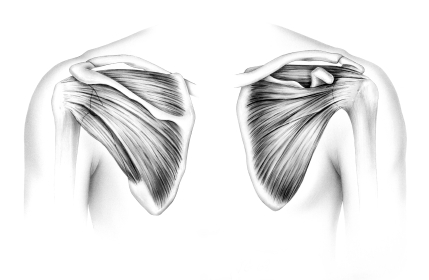Rotator Cuff Tear
So you have a sore, painful shoulder and you’ve been told it’s a rotator cuff tear. But what does that mean? How do you treat a torn rotator cuff muscle? How do you know if your rotator cuff is torn? Let’s start with the basics…
What is a rotator cuff tear?
A rotator cuff tear is a very common injury affecting one (or more) of four different muscles in the shoulder. A tear can be partial or complete and can sometimes involve retraction of the tissue. Rotator cuff tears can be painful but they don’t have to be. They can often be associated with a traumatic event…but they don’t have to be! Rotator cuff tears can occur after years and years of use and are much more common in those people over 60.
Symptoms of Rotator Cuff Tear
Rotator cuff tears typically cause local pain in the shoulder. The pain can also travel down the shoulder toward the elbow. Surprisingly though, you may have one right now and not even know! A 1995 study published in the Journal of Bone & Joint Surgery performed MRI’s on people without shoulder pain. They found that rotator cuff tears in 4% of patients under 40 and in 54% of those greater than 60. A similar study found tears in 40% of those older than 50.
How do you know if you’ve torn your rotator cuff?
A skilled practitioner with the appropriate knowledge to diagnose your condition is obviously essential. One benefit of seeing a chiropractor is that we can order the appropriate x-rays right away. Although a rotator cuff tear is a muscular injury, there are clues that can be found on plain x-rays. Combining this information with certain clinical tests performed during your examination can allow for an early diagnosis so treatment is not delayed.
What is the best imaging for rotator cuff tears?
MRI (magnetic resonance imaging) is known to be one of the most accurate tools for diagnosing rotator cuff injuries. In Ontario, the wait can be long so many patients are referred for a diagnostic ultrasound. Although this modality isn’t as accurate, the wait times are usually shorter and can usually provide an early diagnosis.
Surgery for Rotator Cuff Tears
Surgery is appropriate for some individuals, but there are many different factors to consider. Many rotator cuff tears “re-tear” after surgery. Despite this, surgery can still improve function and decrease pain. Delaying surgery can be a bad idea though; your tear can get larger (especially if you’re over 60 years old), it can retract, can become infused with fat tissue and it can also atrophy (shrink). Each of these events will make recovery more difficult. Surgery is usually a more obvious decision for younger patients with a new, severe tear. Older patients have to carefully discuss with their surgeon and weigh out the benefits and risks.
Should I try more conservative treatment first?
According to the evidence, it is usually a good idea to try conservative treatment (like chiropractic or physiotherapy) for approximately six to twelve weeks prior to choosing surgery. This approach is most suitable for those people who still have some strength in their shoulder. Thinking of waiting to see if it improves? It is generally understood that larger tears will not heal with time. In fact, it would be more likely to get worse and retract. Significant retraction can make surgery more difficult.
Physiotherapy for Shoulder Pain
Our Burlington Chiropractic and Physiotherapy clinic offers many different ways to treat rotator cuff tears. Exercise, interferential current, laser therapy, acupuncture, graston or hands on treatment (like Active Release) are some of our “tools”. The best treatment for rotator cuff tears depends on many factors. Age, the duration of your symptoms, your x-ray findings and clinical findings (like strength) all play a role in the decision making process. Give our clinic a call and start with a diagnosis…we’ll help you figure it out!
Email – info@burlingtonsportstherapy.com
References
Hansen M, Otis J, Johnson J et al. Biomechanics of massive rotator cuff tears: implications for treatment. The Journal of Bone and Joint Surgery 2008; 90(2): 316-325.
Keener JD, Wei AS, Kim HM et al. Proximal humeral migration in shoulders with symptomatic and asymptomatic rotator cuff tears. The Journal of Bone and Joint Surgery 2009; 91: 1405-1413.
Maman E, Harris C, White et al. Outcome of nonoperative treatment of symptomatic rotator cuff tears monitored by magnetic resonance imaging. The Journal of Bone and Joint Surgery 2009; 91: 1898-1906.
Sher JS, Uribe JW, Posada A et al. Abnormal findings on magnetic resonance images of asymptomatic shoulders. Journal of Bone & Joint Surgery 1995; 77:10-15.
Wolf B, Dunn W, Wright R. Indications for repair of full-thickness rotator cuff tears. Americal Journal of Sports Medicine 2007; 35: 1007-1016.
Zingg PO, Jost B, Sukthankar A et al. Clinical and structural outcomes of nonoperative management of massive rotator cuff tears. The Journal of Bone and Joint Surgery 2007; 89: 1928-1934.








